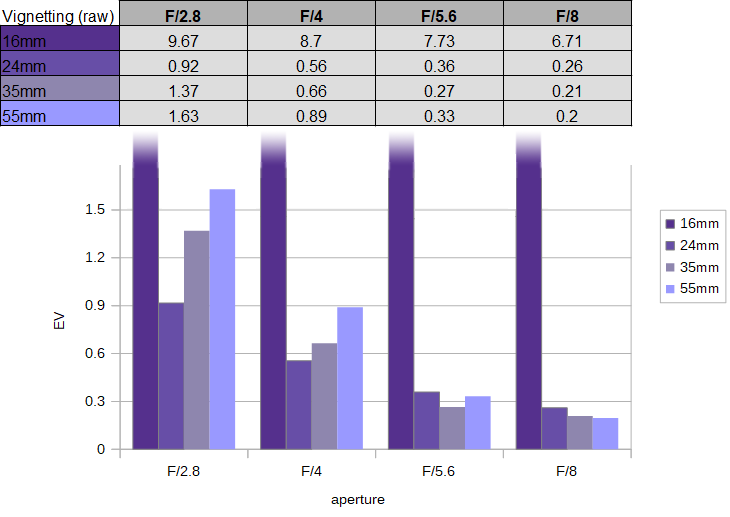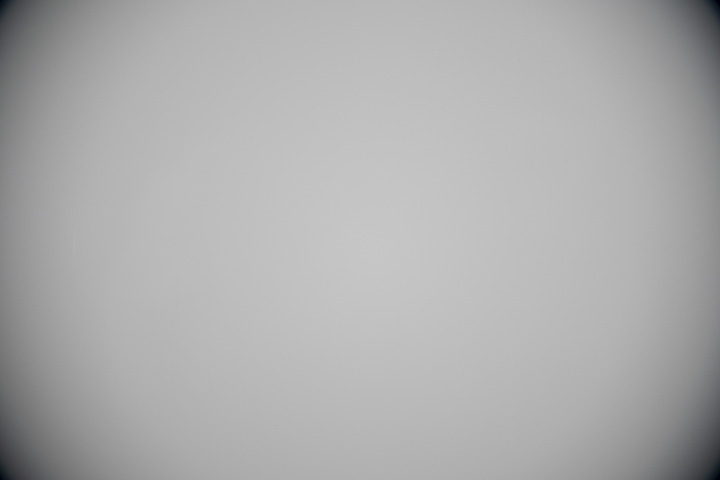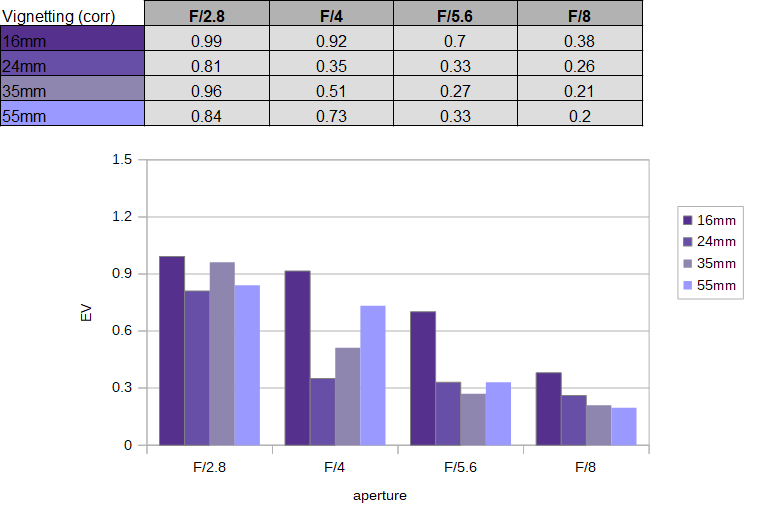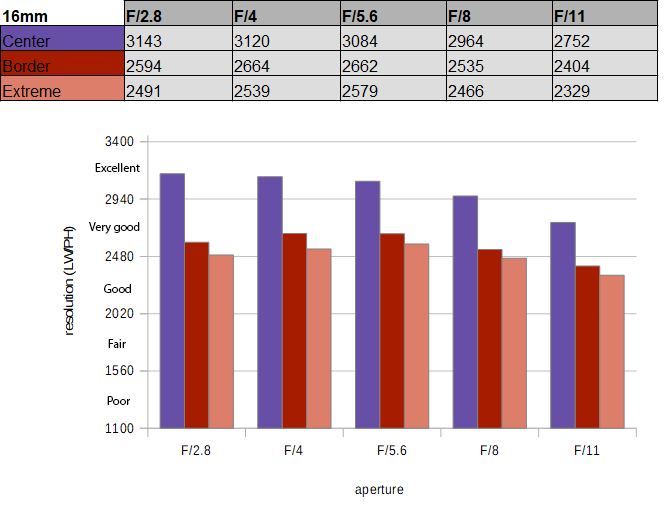|
Sony E 16-55mm f/2.8 G - Review / Test Report - Analysis |
|
Lens Reviews -
Sony Alpha/NEX (APS-C)
|
|
Page 2 of 3

Distortion
Unfortunately, we have to start the formal analysis with an ugly aspect - image distortions.
Let's have a look at the native characteristic first here. At 16mm, the barrel distortion is nothing short of excessive at 8%. That's not a fisheye - yet - but still very disappointing. The issue is reduced to a more sane distortion of ~2.5% at 24mm. At 35mm things have evened out before moving to a medium pincushion distortion of ~1.4% at 55mm.
It is very obvious that Sony never intended to promote low image distortions as merit with this lens. In fact, the in-camera controls for image auto-correction don't even allow switching off distortion control. With activated image correction, there is nothing to worry about in this respect at least.
Vignetting
Moving on to vignetting, we have a look at the raw performance again first. Without any image correction, the results are UNUSABLE at 16mm. The corners are just BLACK at this setting. Once again, it's quite clear that distortion correction just isn't meant to be switched off.
 To illustrate the issue - here's a shot at 16mm f/2.8 without image correction.
To illustrate the issue - here's a shot at 16mm f/2.8 without image correction.
 With distortion correction activated, the black corners are gone at 16mm. The vignetting is still very high at over 2EV at f/2.8, but the results are acceptable from f/5.6 onward. The vignetting is, of course, lower at longer focal lengths with decent results from f/4 onward.
With distortion correction activated, the black corners are gone at 16mm. The vignetting is still very high at over 2EV at f/2.8, but the results are acceptable from f/5.6 onward. The vignetting is, of course, lower at longer focal lengths with decent results from f/4 onward.
 When activating both distortion and vignetting compensation, the results are acceptable at f/2.8 with a light falloff just below 1EV. Some vignetting is still visible at the short & long end at f/4, though.
When activating both distortion and vignetting compensation, the results are acceptable at f/2.8 with a light falloff just below 1EV. Some vignetting is still visible at the short & long end at f/4, though.

MTF (resolution)
So following these mixed results, let's check the "beef" thus the resolution of the Sony E 16-55mm f/2.8 G - and this is where it shines - with one caveat. The center quality is generally excellent at all mainstream apertures and throughout the zoom range. The borders & corners are also superb in the low to mid-range. There's a slight drop at 55mm, but the outer image field is still very good, even at f/2.8. Overall, this is very impressive.
The field curvature is minimal and the centering quality of the tested sample was pretty good.
Please note that the MTF results are not directly comparable across the different systems!
Below is a simplified summary of the formal findings. The chart shows line widths per picture height (LW/PH) which can be taken as a measure of sharpness.
If you want to know more about the MTF50 figures you may check out the corresponding Imatest Explanations
 So that being said ... the above figures were obtained from RAW files. And the story is a little different with activated distortion correction - at least at 16mm. The MTF graph below illustrates how the auto-correction deteriorates the resolution at this setting. It's not super dramatic, but rather than having an almost biting sharpness, the borders/corners are "merely" very good. Even the center suffers a bit, albeit this is probably not noticeable in real life.
So that being said ... the above figures were obtained from RAW files. And the story is a little different with activated distortion correction - at least at 16mm. The MTF graph below illustrates how the auto-correction deteriorates the resolution at this setting. It's not super dramatic, but rather than having an almost biting sharpness, the borders/corners are "merely" very good. Even the center suffers a bit, albeit this is probably not noticeable in real life.

Chromatic Aberrations (CAs)
Lateral CAs are basically absent and nothing to worry about.

Bokeh
The Sony E 16-55mm f/2.8 G may be fast by APS-C standards, but in terms of bokeh, it behaves more like a "24-83mm f/4.3" full format lens, so don't expect wonders in terms of object isolation capabilities. If you want to achieve a decent amount of object solution, you better go close.
The Sony lens has a complex optical design with several aspherical elements. Aspherical elements are never a good precondition for clean, out-of-focus highlights, and it shows. The inner disc zone is quite busy, as you can see below. However, there is almost no outlining, and the discs are perfectly circular even at f/5.6, thanks to no less than 9 curved aperture blades.
 When looking at the disc characteristic across the image field, there is some deterioration towards the corners, but the "good" zone is fairly broad, even at f/2.8. The corner discs have an odd shape, though, which is less pleasing than the "cat eyes" that we are normally seeing here. Stopping down to f/4 helps with this, and the corner discs are mostly recovered by f/5.6.
The general out-of-focus rendition is smooth, especially in the background (shown to the left below). This is clearly better than on most standard zoom lenses.
When looking at the disc characteristic across the image field, there is some deterioration towards the corners, but the "good" zone is fairly broad, even at f/2.8. The corner discs have an odd shape, though, which is less pleasing than the "cat eyes" that we are normally seeing here. Stopping down to f/4 helps with this, and the corner discs are mostly recovered by f/5.6.
The general out-of-focus rendition is smooth, especially in the background (shown to the left below). This is clearly better than on most standard zoom lenses.

Bokeh Fringing (LoCA)
Bokeh fringing is about axial CAs - sometimes also called LoCAs. These are very difficult to remove in post-processing. The Sony E 16-55mm f/2.8 G shows some fringing at f/2.8 - you may stop the greenish tint in the background pattern and the purple one in the foreground. This is rather typical for a lens in this class. Stopping down reduces the issue to a negligible degree from f/5.6.
|